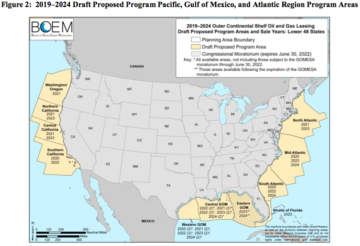
Today, the Trump Administration took a huge step toward disaster with the announcement of their draft proposed five year program for offshore drilling. The proposed plan will foist oil and gas drilling as close as 3 miles to shore along the entirety of the coasts of the lower 48 states, including the Atlantic, Straits of Florida, Gulf of Mexico, and Pacific. Drilling privileges for Atlantic coast areas from Central Florida to Delaware would be auctioned to oil companies beginning in 2020 and for the Eastern Gulf of Mexico area currently under moratorium and Straits of Florida (off of South Florida and the Keys) in 2023. Altogether, the new drilling plan makes 90% of the nation’s waters available for oil companies to drill.
The announcement came in the form of a “Draft Proposed Program”, which lays out a proposed schedule for lease sales of offshore areas to oil and gas companies over a five year span from 2019 to 2024, including 47 total lease sales, including 12 for the Gulf of Mexico, 8 for the Atlantic, and 1 for the Straits of Florida. The proposed program also tentatively rejects any buffer zone around the shore and skips any exclusion of areas due to military, economic, or biological concern, although these could end up being adopted as alternative proposals.
The Trump Administration’s proposed plan is utterly terrible for economic and environmental reasons, primarily because it offers much risk but little reward to our nation. Looking at the Southeast U.S., offshore drilling is nearly impossible to justify based on just a few facts. Firstly, drilling in the Atlantic and Eastern Gulf would pose a direct threat to the coastal tourism economy that generates tens of billions of dollars every year and hundreds of thousands of jobs. It would be a mistake to jeopardize the revenue and jobs we already have from coastal tourism for a relatively minuscule portion from potential drilling. Secondly, widely expanding offshore drilling will not lower the price of fuel for Americans nor will it increase our energy independence. The Atlantic and Eastern Gulf of Mexico combined contain just 2.5% of total technically recoverable U.S. crude oil resources and 0% of proven reserves. This is not an amount that would budge either the price at the pump or boost energy security. Meanwhile, the USA has substantially increased oil and gas production in recent years without huge offshore expansions. For example, between 2008 and 2015, domestic crude oil production nearly doubled and natural gas production increased by a third, while oil imports declined substantially and oil exports grew dramatically.
On the other hand, harnessing indigenous renewable energy, like wind and solar, offer financial savings (wind and solar are now the cheapest forms of electricity in the U.S.), economic development and jobs, and energy security without the large risks of offshore drilling. At the same time, the coming widespread shift to electric vehicles reduces demand for oil and could make oil infrastructure investments into stranded assets.

The publication of the draft proposed program is the second of four major steps the administration must take before offering leases for offshore areas to oil companies. The first major step came last summer, when the administration published a “Request for Information,” and before these sales become official, the administration must still go through a few rounds of public comments and produce an environmental impact statement. However, given that this move to expand offshore drilling flies in the face of overwhelming bipartisan opposition to Atlantic, Pacific, and Eastern Gulf offshore drilling that has been documented for years, it seems that the administration is set on disregarding public opinion. The first round of public comments will begin on Monday, January 8 and will be open for 60 days. Please click here to submit your opposition to offshore drilling and seismic blasting in the Atlantic. After the comment period closes and comments are considered, the administration will publish a Draft Programmatic Environmental Impact Statement (PEIS) and a second-draft version of the 5 Year Program. Several months later, the Proposed Final Program is released along with a Final PEIS. Finally, Congress will review the Proposed Final Program and a Record of Decision will be published. This whole process will likely take about 2 years. The process is difficult to follow, so please see the diagram above, which I find to be a very handy reference. We are now in the “Draft Proposed Program Published” portion of the flowchart, in the upper-left corner. Another resource you may find helpful is the webinar we hosted earlier this year on this plan, which is available here.
Several years ago, we fought President Obama’s dirty, dangerous plans for Atlantic offshore drilling and won. Now, while the primary occupant in the White House has changed in the past year, the facts that make offshore drilling a bad deal for the American public have not. Please stand with us, and the thousands of businesses, 125 local governments, and hundreds of thousands of citizens who have stood up to reject offshore drilling in favor of our coastal economy and quality of life. Join us to fight President Trump’s reckless drive to drill!